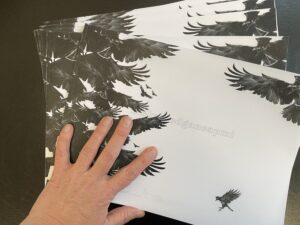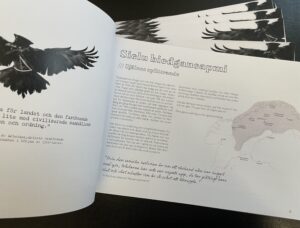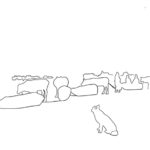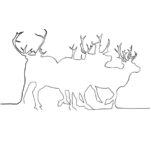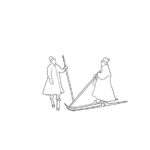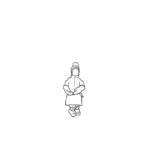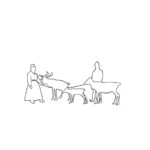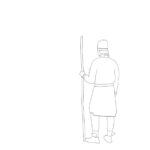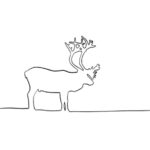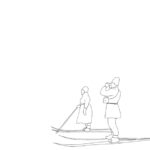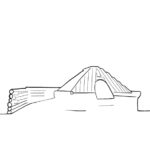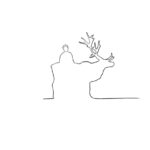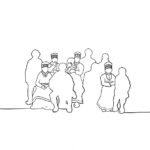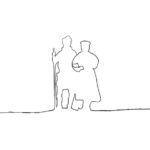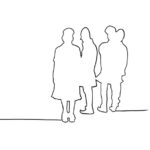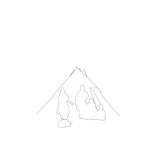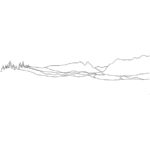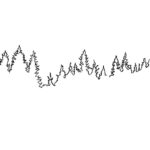THE BROKEN HEART
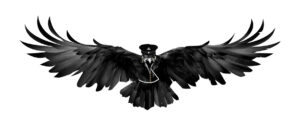
”Nomadic life is a burden for the country and the population which is settled and is hardly in accord with the interests and order of civilized societies.” Statement made in the Norwegian Parliament by the chairman of the Labor Party, Christer Holtermann Knudsen, at the beginning of the 20th century.
Trails through forests and over mountains. Trails where our feet tread softly next to the reindeer’s hooves. Trails which we teach our children to follow. To feel safe. A home to care for. Trails are suddenly dug up and closed off. Such is the history of Sápmi, the Sámi land. People are continually being forced to leave their lands. People move us like pieces in a board game. To new lands with unknown trails. It is a story that began hundreds of years ago and is repeated time and time again. Kings and those in power move us around. Our land is to be used by others. The orders come from above, from the authorities. Those who do not obey are punished. The hearts of the indigenous peoples and the land are tightly intertwined; to have to choose between the land or the reindeer tears us up inside.
This is an exhibition about relocating people by force. You will meet people who share their stories. Start at the invisible Sámi home. Then follow the reindeer rájddo (sled caravan) towards the new lands where visible traces of the forced relocation are barely noticeable. A story which is difficult to tell. It is absent from history books. Sit down in the gåetie, the Sámi home and listen to stories about the new reality. Voices from those relocated and voices of those who were already living in this land.
The exhibition showcase around us is about various forced relocations in Sápmi. They are also about how displacements have affected our sisters and brothers from other indigenous peoples around the world. What does it do to us to be forced off our land? Over and over again. Forced to leave, to become someone else?
Feel free to share your own story.
THE REINDEER RÁIDU (SLED CARAVAN) FROM THE NORTH

“There is room for herds numbering several thousand reindeer. You will get all the help you need. If you move now, you can choose your new lands. If you wait, you will lose that opportunity.” That is what the Lapp bailiff informed them, recounted a displaced person.
One border after another closes. Grazing land after grazing land becomes more crowded. The reindeer and reindeer herders are considered to be in the way. They claim too much land. And they are nomads. Nomads can be moved if you want.
When Norway becomes independent in 1905, Norway comes to an agreement with Sweden to limit reindeer husbandry in certain areas. In 1919, they sign a reindeer herding convention, a new law. Based on these laws they can move herders off some places and give that land to others. In the north, many reindeer herding families move to the summer grazing lands on the Atlantic coast islands. The ink has barely dried when the County Administrative Board forcibly moves the first people south. During these years, Sámi from the north were relocated to almost all Sámi herding-communities in Norrbotten and Västerbotten.
They leave their relatives, sometimes their children. They thank the land for the life it has given them. Few ever go back. They leave their Sámi joik songs behind. But they take their stories with them. The elderly reminisce about their old territory. The exhausting treks with the reindeer rájddo. They call their new home the land of wolverines and bears. The land conflicts that follow do not make life easier. The Sámi who already live on this land want to keep their land, of course. Everyone wants a home.
Forced relocations are a Swedish problem-solving method. As early as the 17th century, and all the way into the 1950s, Sámi families were forcibly relocated.
A HUMAN TIDAL WAVE BY THE JULEV ÄDNO (LULE RIVER)

”Jokkmokk Sámi, get out of the way!” – An informant tells about when the Lapp bailiff sent them south.
During the trek south, almost all forcibly displaced people passed through Jåhkåmåhkke’s forests and mountains. The Lapp administration pointed out places where they were to settle. Many of them ended up in the Sámi herding communities of Sirges and Duorbun.
The Lule Sámi families who already live here are surprised by the reindeer herds and the people who come. Their language is different. Their clothes too. The newcomers give places other names. But not least, they live with the reindeer in different ways. It is not possible to combine. The Lapp bailiff forces them to make room for the newcomers.
The land is getting crowded. They protest, but there is not enough time. Because at the same time the rivers are being harnessed. The reservoirs are filling up, putting the land under water. Cities and industries need electricity. For several years, both those who have inherited the land and those who have been forcibly relocated on the land are forced to give up. The masses of water devour their homes. Ancestral lands. Holy places. The slopes they played on. Their paradise. The reindeer migration routes belonging to the previous lake system are destroyed. The new ice routes are treacherous.
Before the great influx, the reindeer plague had ravaged hard, thousands of carcasses in rotting piles. In the past, those who lost their reindeer could rebuild their flock through hard work. It is no longer possible when the land is taken by others. The loss of that opportunity becomes an inherited wound. They want to continue their reindeer herding and have stricter boundaries between them and the newcomers. The conflicts eventually lead to the formation of the Sámi herding-community Jåhkågasska tjiellde.
The fear of rubbing salt into the wounds makes grief difficult to formulate even today.
FORCED REINDEER SLAUGHTER IN ÁRJAPLUOVVE

”Now we have moved Lapps to Arjeplog, who will teach you to properly care for your reindeer.” – An informant tells about the message from the Lapp’s bailiff’s in 1920.
In 1920, a pandemic rages. Most of the victims are young adults. It is called ”the Spanish flu” and spreads like the wind. In Árjapluovve, it spreads with appalling speed and three out of four fall ill. Fever, chills and dark spots on the skin. The population shrinks dramatically at the same time as the reindeer fall dead from the reindeer plague. When the forced relocation takes place, the newcomers come to an environment that has been marked by illness and death. The lands are not desolate just because people have had to temporarily not use them. Due to the forced relocations, many of the children of the old families from the area have no room to resume reindeer husbandry. They often disappear from the Sámi herding-community.
The following years are described as chaotic. The herds of the newcomers roam quite freely. The reindeer of the Árjapluovvesami are never far away, they must be milked morning and evening. But herds mix and cross the border into Norway. Everyone is punished with hefty fines. Conflicts flare up. During a period of four years, the reindeer owners pay damages of 5.5 million Swedish crowns in today’s value. Everyone complains loudly but the authorities are silent. They do not want to help.
A reindeer herder is interviewed about the conflicts. Does he want to get rid of the newcomers? ”No, of course not. That was never the point. (..) They are Sámi like we are. But the thing is, because of the move, the grazing lands have become very strained.”
The state first decides that there is enough grazing land for all the reindeer, but then changes its mind. Now reindeer must be slaughtered! During the 1930s, the County Administrative Board forcibly slaughtered tens of thousands of reindeer. The authorities thin out the herds without knowledge of which reindeer to slaughter. Piles of carcasses lead to falling meat prices. In many other places in Sápmi reindeer are also slaughtered by force, but not as drastically. The slaughter may be spread out over several years. The brutality of the reindeer slaughter in Árjapluovve is widely talked about. It is said that the Lapp bailiff ravaged the reindeer herd worse than the wolf.
SOUTHERN SÁMI AREA TORN APART

”Shut down the five southernmost Sami herding-communities!” – Proposal from the Parliament’s committee on border grazing.
JUDGMENT OF EAJRA
When the union between Sweden and Norway was dissolved in 1905, all Sámi herding-communities along the new border were affected. In Norrbotten and Västerbotten, a few reindeer are allowed to move to the old grazing lands, but only during certain times of the year. In Jämtland and Dalarna, not a single reindeer is allowed to cross the border.
The reindeer migrate on their usual paths as they always have. Norway says it is illegal because Sweden has signed an agreement. The state comes up with a brutal solution: Close down the five southernmost Sámi herding-communities! Disagreements between the reindeer herders in the two countries and harsh words from the farmers inflame the conflict. The Sámi give suggestions for solutions. Merge two Sámi herding-communities! Buy land with money in the Forest Fund! Set up a fence!
Instead, the Sámi are persuaded to apply for relocation north to Tåssåsen. They apply but regret it when they find out that the reindeer there have a hoof disease. The move is canceled. They return home but are punished and brought to justice. They fight in the manorial court for permission to stay. They win but the verdict is appealed to the Svea Court of Appeal. They lose and are not allowed to appeal again. If you want to continue being reindeer herders, you have to move!
The reindeer or the land. What do you choose? The forced relocation splinters families. Children and grandchildren move with the herd. The elderly stay. Some become poor and bitter, but at least they remain in their homelands. The new reality in Tåssåsen is harsh. The grazing lands are crowded. The disease spreads. Reindeer drown in the spring because of treacherous ice on the lakes when they try to return to their old grazing lands. The authorities force the herders to slaughter their animals. By then, the disheartened reindeer herders give up their struggle.
Three years after the verdict, the authorities suddenly change their minds. Once again there are to be reindeer in Eajra. Large families may apply to move down, but those who were previously relocated cannot apply.
EVACUATED FROM FJÄLLSJÖN
The whole village is to be demolished! The houses are in poor condition and need to be renovated. They are not worth repairing. In other villages, Swedish families receive loans to build new houses. This does not apply to the Sámi here. Fjällsjön is too far away, only a horse trail leads there. They have wanted a road for a long time, but the municipality says it is unrealistic. It is considered more practical and cheaper to move 70 people.
In 1953 the authorities promised a new village would be built, with real houses and large plots of land around them. Now the banks are suddenly offering loans. It is not really known where the new village will be located. The Sámi themselves think that Brändåsen is suitable. The reindeer have grazed there for generations and the place is uninhabited. But the farmers in the area protest. Fears are expressed on both sides. What if the Lappish people take our jobs? What if the young Lapps stop herding reindeer? What if the Sámi girls marry farmers?
Finally, the village is built in Brändåsen. But the houses which were promised never become a reality. Instead, they get barracks built on plinths. Ice-cold winds blow through the cracks in the floor and many get sick. Water freezes in the buckets and the potatoes have to be wrapped in reindeer skins and put in the drawer in the kitchen sofa to prevent them from freezing. In 1955 the municipality announces that the houses are almost finished…. What is still lacking is running water, drainage, proper insulation, electricity and paint on the façades. At the same time, they are forced to demolish their old houses. No one is allowed to live in Fjällsjön.
IN THE EAST

“For the prosperity of civilization and modern life for the whole majority – some minorities must suffer.” Summary of the state’s policy on development. From Anna Afanasyeva, 2013, p.33.
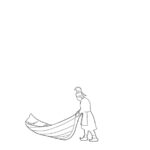 “Why would you go there again? It is flooded, the houses are gone, there's nothing left. (…) It looks terrible, it was scary at first, rotten trees, rotten planks, everything is floating all over the place, here and there you see a floating window, or doors. It´s a real nightmare. ”- cited in Anna Afanasyeva, 2013, p.43.)
“Why would you go there again? It is flooded, the houses are gone, there's nothing left. (…) It looks terrible, it was scary at first, rotten trees, rotten planks, everything is floating all over the place, here and there you see a floating window, or doors. It´s a real nightmare. ”- cited in Anna Afanasyeva, 2013, p.43.)TOWNS ON FIRE
The flames scorch even the treetops, the smoke irritates their noses. Their villages are on fire and only ashes remain. In the possession of the Skolt Sami there is a wooden box that must be saved, a unique collection of agreements, the oldest 400 years old, between them and the Russian Tsar. Nine meters of text in a scroll, recognizing their rights to land and water. It is kept in a secret place. Only three trusted elders, all from different families, know where. The people must be moved quickly south and the box is hidden in the bow of a boat by a shed. With the war on its way the box is left with trepidation. A military man finds the box. He realizes how important it is and hands it over to his superior.
People are moved to unknown places. Some arrive in Kalajoki on the Finnish coast. By military trucks they are taken to cold fishing cabins by the sea. The young children get runny eyes and snotty noses. Unknown diseases take the lives of loved ones. Here they live waiting, evacuated and cut off from their previous lives. The contrast is like night and day compared to everyday life around their own lake. With nets in the water, lasso in hand, rifle hanging on their back, always close to family. They long for home, but almost all the ways back are closed.
The Soviets are building an iron curtain through the land of the Skolt Sámi. A fence with towers, guarded by soldiers. Weapons aimed at Finland and Norway. Families are broken up, separated between different countries. Many never return to their old home areas, only a few can eventually return to the few cottages that remain.
Good-hearted fellow human beings from England raise money for new reindeer herds. In the reindeer grazing land of the Ánar Sámi, in present-day Finland, logs are used to make small log cabins. Here, the Skolt Sámi should be able to live their traditional lives, the authorities think. Just like in the rest of Sápmi, their culture is threatened today. The right of indigenous peoples to their land is always put into question.
GATHERED FOR TRAGEDY
Yet another one buried. We walk slowly along the street with dilapidated small gray houses. Dogs bark loudly and sheep bleat curiously. We are moving in the direction of worn concrete buildings, towards the core of Lujávri (Lovozero). In just one month, our Sámi villages are emptied, everyone is brought here in trucks. As cattle, we are unloaded and left without a roof over our heads. We trust that relatives who have previously been moved here can crowd together. There is not enough floor space, when some need to sleep, others have to go out. For several years we have lived like this, without anything worthwhile to do.
Questions about the one who died are being asked. Was it suicide this time? We will never know how the lungs of the deceased were filled with water. We see how the spark disappears from the eyes of our loved ones. How hope for the future disappears. You cannot make a family here. Where would one live? With what would one work? The girlfriend’s broken heart is worrying. Does she now have to encourage the Russian man’s courtship? The longing for the old way of life engulfs us with sadness. Together we remember how the elderly and children hunted together. Fished salmon and picked healthy berries on the tundra. The reindeer were our close friends. The reindeer and the Sámi have a similar personality, we do not like to be forced into a structured life. We need a large living space and great freedom to feel good, we state sadly. The stories we heard as children about when they took the reindeer away from us come up. We were no longer allowed to own our own reindeer, everything was to be run collectively as an industry. Forty reindeer herders who dared to protest were executed and fifty were sent to labor camps.
A whole lifetime of drastic changes. Expulsions, thefts and murders. The right to land and water gradually vanishes. Foreign tourists with thick wallets are allowed to catch salmon after salmon while the rivers are off-limits for us. Poverty, unemployment and homelessness. Radioactive waste dumped here poisons life, the badly kept mines squirt sick water into the environment. The industries demand more electricity. Homes, pastures and relatives’ graves all end up under water as hydroelectric power is expanded. Lands that we ourselves once controlled and which shaped our lives are no longer on the maps. It’s like they never existed.
DISAPPEAR OR BECOME A PARISH LAPP

“Commanders in Dalarna! All Sámi must be captured and sent to Lapland!” Governor Danckwardt, 1729.
King Fredrik I is outraged. There is no game to hunt! His hunting guests blame it on the Sámi who shoot everything. The Sámi have to be moved away. The king also wants to create more agricultural land, so more taxes can be collected. Reindeer husbandry is in the way. The Sámi are driven away to the mountains by more and more laws. But the farmers need their know-how. They are good hunters and they can kill and slaughter animals which the farmers prefer not to do. The Sámi can also cure the sick and create tools such as ropes and baskets. They protest together against the laws and finally the king listens to the peasants. The professional title ”parish Lapp” is created.
Only one Sámi family is allowed to stay in the village and work. But they must settle down, go to church and not migrate. No more migrating with the reindeer. It is not certain where the rest of the Sámi go. They disappear from the church records. In old documents one can read about how the Sámi are chased away or arrested.
The parish Lapps are to sit at the back of the church. They are to go into houses through the kitchen door. They live in a cottage some distance away from the village. Their services are sometimes paid for in cash, sometimes with food. The job can be inherited, passed down from parent to child, if the village agrees to it. Any Sámi who misbehaves is expelled from the village. The parish Lapps never become integrated into the community. Maybe they did not want to. They often marry other parish Lapps or other Sámi who pass by. They gradually lose their language and quit using their Sámi clothes. A forbidden instrument, a drum, is hidden under the floor, and found 50 years later in one of their abandoned cottages.
Machine-made ropes and baskets replace hand-made ones. The profession is abolished. The parish Lapp is no longer needed.
OUR DISPUTES TODAY

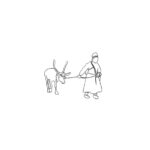 “We have always been welcomed there by the locals. We grew up together as children. But from one summer to the next, we were no longer welcome. We were welcomed by the locals but not by Norwegian authorities who see us as outsiders.” Per-Anders Nutti, chairman of Saarivuoma Sámi village being questioned in the Court of Appeal in July 2020.
“We have always been welcomed there by the locals. We grew up together as children. But from one summer to the next, we were no longer welcome. We were welcomed by the locals but not by Norwegian authorities who see us as outsiders.” Per-Anders Nutti, chairman of Saarivuoma Sámi village being questioned in the Court of Appeal in July 2020.The arguments are repetitive, they both think when their eyes meet. How often have they not heard the same thing from government representatives? Courthouses are familiar places now after decades of being summoned to court. Even when they were young, the same thing was discussed. At that time, Norway’s Supreme Court admitted that the Sámi village certainly has the right to the pastures that they have used for hundreds of years. But peace did not last long, only four years later Norway closed the borders again. Even today, the countries cannot agree on when and where the reindeer will be allowed to graze. Saarivuoma persistently continues to fight. They can never give up.
Stormy weather and no visibility, the wind blows and the rain whips against your cheeks. How do we gather the herd together fast enough? The weather does not care about dates. A hefty fine awaits those who do not succeed in moving the reindeer to the right area on time, we know that already. Talma has lost lands on both the Norwegian and Swedish sides. Year after year they struggle against the wind. Sweden continues to give their land to Norway without involving the Sámi herding-community. In 2019, the state is charged for its illegal actions. Hope has been kindled.
In the Lycksele District Court the air is still. Jaws are clenched. Eyes focused. Emotions do not belong here. The atmosphere is icy cold and shivers run down your back. How could it turn out like this? Sámi against Sámi. We all know that the conflict is not ours. The conflict of Vapsten is terribly infected. In 2017, some of the old Vapsten Sámi sued the newcomers who received reindeer husbandry rights in the area. The District Court ruled in 2020 that both have an equal right to reindeer husbandry, hunting and fishing. It is very unusual, since the court is supposed to say who is right and who is wrong. Both sides are sentenced to share the legal costs. But the District Court is reprimanded, and the verdict annulled. Back to square one.
SISTERS AND BROTHERS

”You cannot do enough to equip the children with as many healthy and good rules of conduct as possible if you have just a small hope of getting the population out of the downright filth in which it now lives.” – Dr. Kai Ludvigsen, Danish Red Cross (Quote from Dr. Kai Ludvigsen who was sent to Greenland by the Danish Red Cross)
I’m seven years old when I return to Kalaallit Nunaat eighteen months later. I run into my mother’s arms and start telling about everything I’ve been through. But mother does not answer. She does not understand what I’m saying. I can no longer speak Greenlandic.
The little girl is not allowed to come home. Instead, she is moved to an orphanage where she has to speak Danish. The parents are only allowed to visit on a Sunday every three months. She has lived there for eight years. She is never reconciled to the fact that her mother sent her to Copenhagen, even though she knows that there was no choice. The theft of the 22 children in 1951 has been called ”the Danish experiment”. Both the Red Cross and the Danish Prime Minister have today apologized for their cruel way of “Danishizing”.
Thousands of similar stories took place in Australia as late as in the 1970s.
The executives of certain authorities picked up children from their homes at their own discretion and placed them in workhouses or to work at white families. A woman who wants to adopt says that she simply goes to the manager who agrees that she can have Mrs J’s youngest boy. ”She still has three. If Mrs J protests, we just threaten to take all of them.”
The children’s stories about their new lives involves a stinking pile of hard work, homesickness, bullying, abuse and sexual abuse. Girls who in turn are forced to leave their newborn children. No one knows how many children were stolen from their parents, but there is talk of there being 25,000-100,000 broken hearts.
Abuse has taken place in many scary episodes throughout the course of history.
The worn wheels of the wagons on the prairie. Tired steps, bodies left behind, tears falling onto the dusty road on the way to unknown lands. The Trail of Tears is trampled on as white men take over the land of indigenous peoples with violence, and politics in the 19th century. At least 60,000 people in North America are displaced. Thousands die of hunger, disease and exhaustion during the far far journey.
According to the UN Declaration on the Rights of Indigenous Peoples, people cannot be forced to move against their will. The right to the land is regulated by international law. Despite this, indigenous peoples are to this day still being forcibly displaced.
